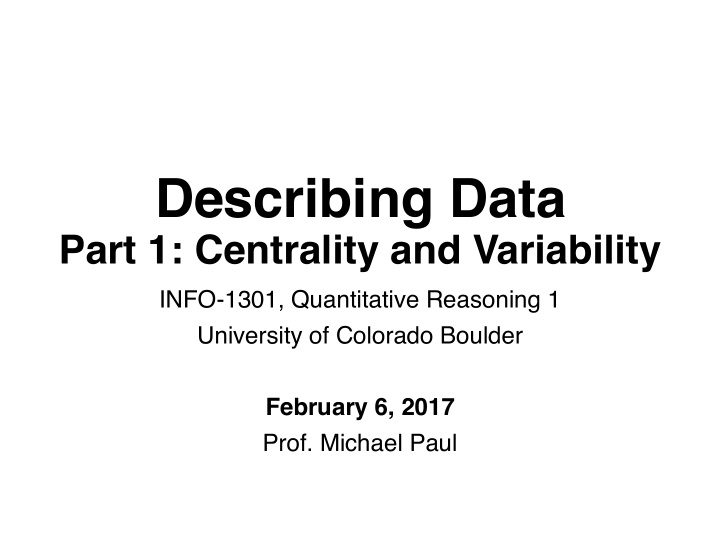



Describing Data Part 1: Centrality and Variability INFO-1301, Quantitative Reasoning 1 University of Colorado Boulder February 6, 2017 Prof. Michael Paul
Descriptive Statistics • Statistics that summarize a dataset • Provide information about samples, but not necessarily populations Two main categories: • Central tendency • Variability
Measures of Central Tendency Three Ms: • Mean • Median • Mode When to use one over another?
Mean • Also called the average • Sum of all the data points divided by the number of data points • Example: 1,2, 4, 4, 5, 9 • The mean is (1+2+4+4+5+9)/6 = 25/6, or approximately 4.17 • Note that the mean is not necessarily one of the numbers that appeared in the data set
Mean • Example: staff salary (thousands of dollars): 15, 18, 16, 14, 15, 15, 12, 17, 90, 95 • The mean is $30.7 thousand • But most of the salaries are in the 12-18K range. What happened? • When not to use the mean: when there are outliers
Median • The middle value • Procedure: order the data in ascending order • if an odd number of data points, pick the middle one • if an even number of data points, average the two middle ones • Example: 65, 55, 89, 56, 35, 14, 56, 55, 87, 45, 92 • Reorder: 14, 35, 45, 55, 55, 56, 56, 65, 87, 89, 92 • Median is 56. • Example: 11, 19, 26, 24, 17, 3 • Reorder: 3,11 ,17 , 19 ,24,26 • Median = (17+19)/2 = 18
Median • Median is less sensitive to outliers • Salary example: 15, 18, 16, 14, 15, 15, 12, 17, 90, 95 • Reorder: 12, 14, 15, 15, 15 , 16 , 17, 18, 90, 95 • Median is 15.5
Mode • Most common value in the dataset • Often used for categorical data • Example: Transportation to campus: car (10), bus (23), walk (8), bicycle (13), skateboard (9) • Example: Height of students in this class in millimeters: 20 different values (even though some close) so no mode • Mode rarely used with continuous data
Measures of Central Tendency Which to use depends on the application • Mode is least common for numerical data, but most common for categorical data • Median is better when there are outliers • Mean is better for a small amount of data
Measures of Variability How much do points deviate from the average? • Consider two data sets: • A is 4,5,6,7,8 • B is 2,4,6,8,10 • The mean is the same in both cases. • But you can intuitively say that data set B varies more from its mean that data set A.
Measures of Variability How much do points deviate from the average? • Variance • Standard deviation
Variance Dataset A: 4,5,6,7,8 • Calculate difference between each point and the mean • 4-6 = -2 • 5-6 = -1 • 6-6 = 0 • 7-6 = 1 • 8-6 = 2 • Square each difference: 4, 1, 0, 1, 4 • Then average the squares: (4+1+0+1+4)/5 = 2
Variance Dataset A: 4,5,6,7,8 A more accurate way to calculate variance is to divide by one less than the actual number of observations • Average the squares: (4+1+0+1+4)/4 = 2.5 The math behind this is beyond the scope of this class. We’ll allow either method in this class.
Standard Deviation Standard deviation is the square root of variance Standard deviation is usually denoted with σ and σ 2 is variance • Standard deviation is a more common statistic than variance (but you can get one from the other)
Standard Deviation Standard deviation can tell you the distribution of values in your dataset. In a typical dataset: • 60% of data will be within 1 σ of the mean • 95% of data will be within 2 σ of the mean Dataset A: 4,5,6,7,8 Standard deviation is 1.6 5, 6, 7 (60%) within 1.6 of the mean 4,5,6,7,8 (100%) within 3.2 of the mean
Percentiles • Sometimes you want to know how a particular value compares to the entire dataset. • For ordinal variables, we can create percentiles • Example: SAT scores are given in percentiles. Thus if you are in the 90 th percentile on a given variable (e.g. you SAT general math aptitude test), that means your value is higher than 90% of the people who took the test at the same time.
Percentiles • 25 th Percentile: First Quartile (Q1) • 75 th Percentile: Third Quartile (Q3) • 50 th Percentile: Second Quartile (Q2) • Also called the median! • Inter-quartile range (IQR) = Q3 – Q1 • Tells you how spread out the middle 50% are • Another way of measuring variability/spread
Percentiles IQR = 119 – 31 = 88
Outliers Loose definition: values that are unusually far away from other values in a dataset No single definition, but common definitions: • More than 2 standard deviations away from the mean (in either direction) • More than 1.5*IQR below Q1 or more than 1.5*IQR above Q3
Robustness
Practice cu-salaries dataset in D2L 5 job categories: • Regular faculty (professors) • Research faculty (researchers, postdocs) • Other faculty (lecturers) • Classified staff (office staff, laborers) • Officer/Professional (directors, deans)
Practice 1. In which job categories is the mean larger than the median? In which is it smaller? In which is it about the same? Why? 2. How many outliers are there for each job category? Are the outliers high or low? 3. Which department has the highest median salary? Which has the lowest? 4. Look at each department’s salary histogram and say whether it appears to be left-skewed, right-skewed, or symmetric.
Recommend
More recommend